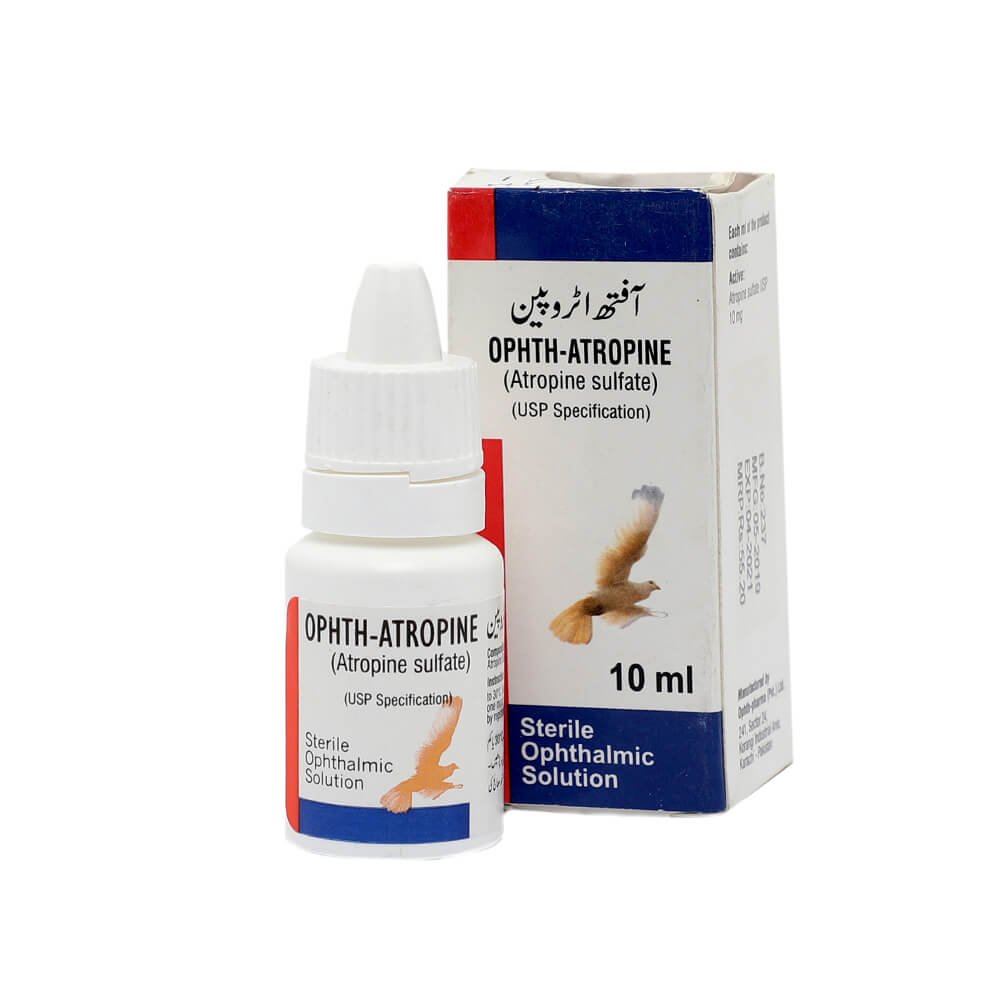delivery within 72 Hours
OPHTH ATROPINE EYE DROP
₨ 100
Product Title: OPHTH ATROPINE EYE DROP
Generic: atropine
Pack Size: 10ml
Product Form: DROP
Delivery within: 2 to 3 working days across Pakistan
Shipping & Delivery
-
Courier delivery
Our courier will deliver to the specified address
2-3 Days
From Rs 250
-
Free 15-Day returns

Black Friday Blowout!
Description
Ophth Atropine Eye Drop contains the active ingredient atropine, which belongs to a class of medications known as anticholinergic agents. Atropine eye drops are used to dilate the pupil (mydriasis) and temporarily paralyze the muscles of the eye’s iris, allowing for better examination of the retina and other internal structures of the eye. Ophth Atropine Eye Drop is commonly prescribed by ophthalmologists for diagnostic and therapeutic purposes in various eye conditions.
Key Ingredient:
- Atropine: Atropine is a naturally occurring alkaloid derived from the belladonna plant. It works by blocking the action of acetylcholine, a neurotransmitter responsible for controlling pupil size and regulating the muscles of the iris. By inhibiting the parasympathetic nervous system, atropine causes pupil dilation and paralysis of the ciliary muscles, leading to relaxation of accommodation (cycloplegia).
Uses:
Ophth Atropine Eye Drop is used to:
- Dilate the pupil (mydriasis) before ophthalmic examinations, such as fundoscopy, retinal imaging, or refractive assessments.
- Induce cycloplegia (paralysis of accommodation) to accurately measure refractive errors (e.g., astigmatism, hyperopia, or myopia) and determine the appropriate prescription for corrective lenses (glasses or contact lenses).
- Treat certain eye conditions, such as uveitis, iritis, or amblyopia (lazy eye), by temporarily immobilizing the affected eye and reducing pain or inflammation.
- Manage conditions that require temporary relaxation of the ciliary muscles, such as accommodative spasm or certain types of strabismus (eye misalignment).
Ophth Atropine Eye Drop is administered by a healthcare professional, usually in an ophthalmologist’s office or clinic setting, and may require multiple applications to achieve the desired therapeutic effects.
Directions for Use:
Follow the instructions provided by your ophthalmologist or healthcare provider regarding the use of Ophth Atropine Eye Drop. Tilt your head back, pull down the lower eyelid to create a small pocket, and instill the prescribed number of drops into the affected eye(s) using a sterile dropper. Close your eyes gently and press on the inner corner of the eye (nasolacrimal duct) for a few seconds to prevent drainage of the medication into the tear duct and systemic absorption.
Precautions:
- Inform your healthcare provider about any medical conditions you have, especially glaucoma, Down syndrome, or a history of adverse reactions to anticholinergic medications.
- Avoid touching the tip of the dropper to prevent contamination of the eye drop solution.
- Do not drive or engage in activities requiring clear vision immediately after instilling Ophth Atropine Eye Drop, as it may cause temporary blurring of vision and sensitivity to light.
- Use caution when administering Ophth Atropine Eye Drop in children, as they may be more susceptible to systemic side effects, such as increased heart rate, dry mouth, or urinary retention.
Frequently Asked Questions (FAQs):
- How long does the dilation effect of Ophth Atropine Eye Drop last? The duration of pupil dilation (mydriasis) and cycloplegia induced by Ophth Atropine Eye Drop may vary depending on factors such as the concentration of atropine used, individual response, and metabolism. Typically, the effects can last several hours to days.
- Are there any side effects associated with Ophth Atropine Eye Drop? Common side effects of atropine eye drops may include temporary blurred vision, sensitivity to light, stinging or burning sensation, and discomfort. Rarely, systemic side effects such as increased heart rate, dry mouth, or allergic reactions may occur.
- Can Ophth Atropine Eye Drop be used in infants or young children? Ophth Atropine Eye Drop may be used in infants and young children under the supervision of a pediatric ophthalmologist or healthcare provider for specific diagnostic or therapeutic purposes. Dosage adjustments and close monitoring are essential in pediatric populations.
- Is Ophth Atropine Eye Drop safe for use during pregnancy or breastfeeding? The safety of Ophth Atropine Eye Drop during pregnancy or breastfeeding has not been well established. Pregnant or breastfeeding individuals should consult their healthcare provider before using atropine eye drops to assess the potential risks and benefits.
- Can Ophth Atropine Eye Drop be used for cosmetic purposes? Ophth Atropine Eye Drop is not intended for cosmetic use to permanently change eye color or alter the appearance of the iris. Its use should be limited to diagnostic or therapeutic purposes under the guidance of a qualified healthcare professional.
Customer Reviews
You must be logged in to post a review.







Reviews
Clear filtersThere are no reviews yet.